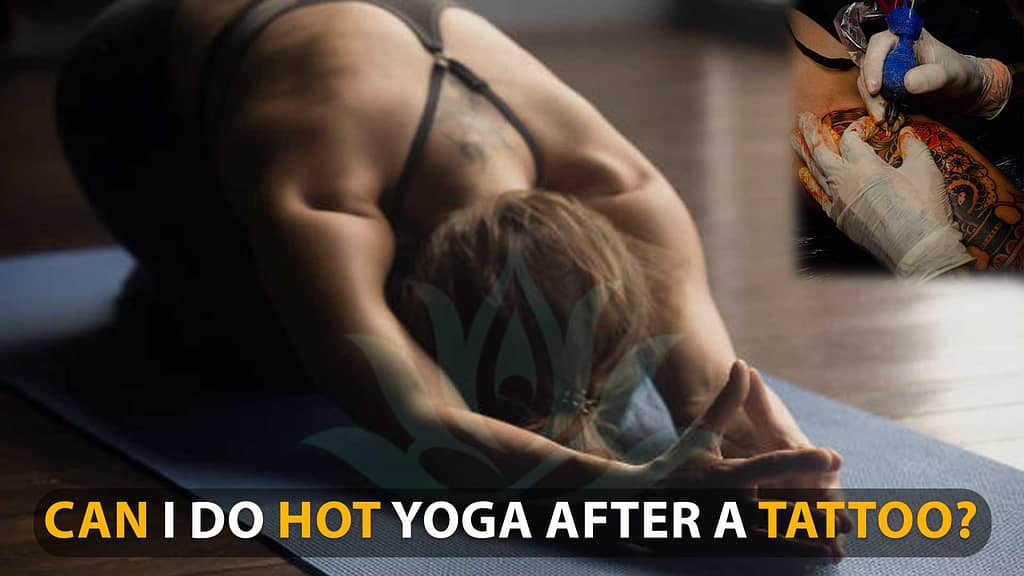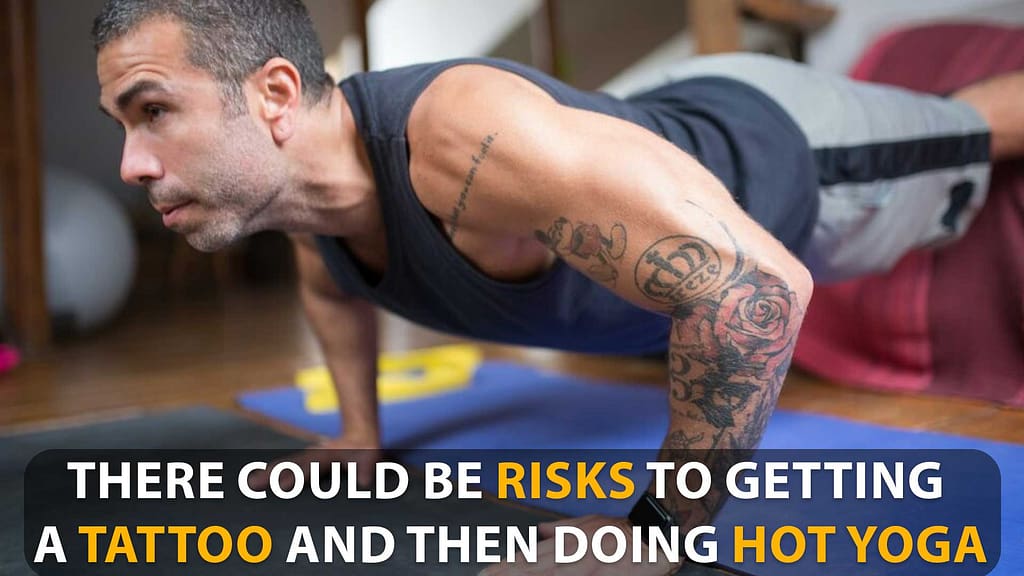Can I Do Hot Yoga After A Tattoo? – Everything You Need To Know In 2024

Can I do hot yoga after a tattoo?
No, you should avoid it. Most people say you shouldn’t do hot yoga or any other hard physical exercise right after getting a tattoo. Tattoos are open wounds, and exposure to too much heat, sweat, or pressure can dim the healing procedure and make it more likely that something will go wrong.
How a tattoo heals is important to know?
Learning how a tattoo will heal is essential before getting one. Tattooing is making an open hole in your skin and putting ink into it. Usually, the healing process happens in stages, and each stage is important for how your tattoo will look.
1. Aftercare Right Away
When you get a tattoo, your expert will guide you on how to take care of it immediately. Mostly, this means having the tattoo clean and well-moisturized.
You might be told to wash the tattoo lightly with water and gentle soap, pat it dry with a clean towel, and then put a thin layer of ointment or moisturizer made for tattoos.
2. Scabbing and Peeling
The tattooed area may begin to scab and peel within the first week or two after it has been applied. This is a common part of the healing procedure as your body tries to fix the broken skin. It’s important not to pick or scratch at the scabs to keep them from burning or losing color.
3. Itching and flaking
Your skin might itch and flake as the tattoo heals. This is also a normal sign that your skin is getting new cells. It’s important to fight the desire to scratch the marked area so you don’t hurt the skin as it heals.
4. Complete Healing
A tattoo can take a few weeks to a few months to heal. This turn on the size and complexity of the tattoo, your skin type, and overall health. During this time, your skin will keep growing back, and the tattoo will take on its final look.
5. During the healing process
It’s important to keep the tattoo clean, from getting too wet (like when you go swimming), and keep it out of the sun for a long time. These steps help healing go well and stop problems from happening.
Remember that everyone heals a little differently, so it’s important to follow the treatment directions that your tattoo artist gives you. If you have any worries or questions while your tattoo is healing, it’s best to talk to your tattoo artist or a doctor. They can give you advice that is unique to your tattoo and how it is healing.
Read:
Can Chronic Kidney Failure Be Healed By Yoga And Meditation? 5 Effective Poses For CKD Patient
Highlight the significance of tattoo upkeep

Expert care is a must for your tattoo to heal and last as long as possible. Follow the treatment directions your tattoo artist gives you to ensure your tattoo heals well, keeps its color, and reduces the chance of problems. Here are a good few of the most vital reasons why aftercare is so important:
1. How to Keep from Getting Infected?
Tattoos are open wounds so that they can get infected. With proper aftercare, like keeping the tattoo clean and practicing good hygiene, germs or other pathogens are less likely to get into the area and cause an illness.
When you clean your skin regularly and use the recommended ointments or lotions, you create a shield against possible contaminants.
2. Helping the Tattoo Heal Right
Caring for your tattoo is more likely to heal right. Doing things like gently cleaning the tattoo and putting on the right products can keep the area clean, hydrated, and safe. This helps healthy new skin cells form and prevents problems like scars, color loss, and uneven healing.
3. Minimizing Pain and Itching
Tattoos can cause pain or itching as they heal. With the right care, these problems can go away. Keeping the tattoo wet helps to calm the skin and stop burning.
If there are any specific instructions for avoiding irritation, like staying away from certain fabrics or activities, this can also help to reduce pain.
4. Keeping a Tattoo Vibrant
If you care for your tattoo, it will keep its color and clarity over time. Taking care of your tattoo correctly can help keep its color and stop it from fading.
This means keeping the tattoo out of the sun as much as possible, using the right sunscreen when needed, and avoiding activities or products that could hurt or fade the tattoo.
5. Ensuring Long-Term Satisfaction
Your tattoo is a lasting part of your body, and how well you take care of it afterward greatly impacts how it looks in the long run. Taking care of your tattoo while it’s healing can improve its general quality and make it more likely that you’ll be happy with the result.
your tattoo artist may give you slightly different directions on how to take care of it afterward, depending on how experienced they are and what kind of tattoo it is.
Listen carefully to what they say, and don’t delay to contact them if you have any questions or concerns as you heal. Taking care of your tattoo correctly will help you enjoy it for years.
Read:
Is Yoga Considered A Type Of Hindu Ritual? – Separating Myth From Reality 2023
Possible risks and worries about how a tattoo will heal

Even though getting a tattoo and letting it heal is usually easy, there are some risks and worries you should be aware of. If you realize these risks, you can take the right measures and make sure you heal well. Here are some risks and worries that could happen:
1. Risk of infection
When the skin is fragmented, there is a chance of getting an infection. If you don’t do the right things after getting a tattoo, bacteria or other germs can get into the area and cause an illness.
There may be more pain, redness, swelling, pus, or fever as signs of an illness. To lower the risk of infection, it’s important to keep the tattoo clean, avoid touching it with dirty hands, and do what your tattoo artist tells you to do after the tattoo.
2. Responses to tattoo ink or other things used during the tattooing process
Some people may have allergic responses to the tattoo ink or other things used. Around the tattooed area, allergic responses can show up as itchiness, redness, a rash, or swelling. You should visit a doctor at once if you have any strange or extreme responses.
3. Bad Healing or Complications
Things like not taking care of a tattoo properly after it’s done, doing too much physical exercise, or having certain medical conditions can make it take longer for a tattoo to heal.
A wound that doesn’t heal well can leave a scar, lose color, or look uneven. It’s important to follow your tattoo artist’s treatment advice, stay away from things that could hurt or irritate the tattoo, and see a doctor if you’re worried about how well it’s healing.
4. Fading or Color Changes
Tattoos may fade or change color over time. This can happen faster if you spend too much time in the sun, don’t take good care of your skin afterward, or use hard skin care products.
Protect your tattoo from the sun by putting on sunscreen and keeping it fresh. This will keep it from fading or changing color too much.
Some people are more likely to get higher and thick scars than the skin around them. These are called keloid or hypertrophic scars.
Not withstanding that it has nothing to do with tattoo healing, it’s important to know that people who have had keloid or hypertrophic scars in the past may be more doubtless to get them around their tattoos.
If you tend to get these kinds of scars, you should talk to your tattoo artist or a doctor about it before getting a tattoo.
It’s vital that everyone heals differently and that problems are rare. Following the treatment instructions, keeping good cleanliness, and getting professional help can reduce the risks and ensure your tattoo heals well.
Read:
How Long Does It Take To Become Good At Yoga? – Mastering The Art Of Yoga In 2023
There could be risks to getting a tattoo and then doing hot yoga

Due to the high heat, sweat, and physical activity, doing hot yoga right after getting a tattoo can lead to several risks and problems. Here are some risks to consider:
1. Increased risk of infection
Hot yoga rooms are warm and humid, making them a good place for germs to grow. Since a new tattoo is an open cut, letting it get too hot or sweaty can make it more likely to get infected.
Bacteria like warm, wet places to live, and if you sweat much due to hot yoga, you may bring dangerous bacteria to the tattooed area. This could cause an infection.
2. Broken Healing Process
For a tattoo to heal, it needs the right amount of moisture, cleaning, and security. Hot yoga can reduce this balance by making the tattoo sweat, rub, and stretch too much.
Heat and movement can make the tattoo sensitive, swollen, or even hurt, slowing the healing process. Also, sweating too much can wash away the ointments or creams you put on the tattoo, which are important for it to heal properly.
3. Loss of color or fading
Heat and sweating can cause a new tattoo’s color to change or fade. High temperatures and a lot of sweat can make the ink spread or fade faster than it should, giving the tattoo a less bright or patchy look. To keep the tattoo’s original color and get the best long-term results, keep it away from extreme heat and sweat.
4. Pain and discomfort
Hot yoga involves a lot of strong physical exercise and poses that may put pressure on or stretch the area where you have a tattoo.
This can hurt, hurt the tattoo or even damage it, especially when the skin is still sensitive and the tattoo is just starting to heal. When heat, sweat, and physical activity come together, it can worsen pain and slow the mending process.
Due to these risks, it’s usually best to avoid hot yoga or any other intense physical activity that could slow down the healing of your tattoo. Go around with the treatment guidelines given to you by your tattoo artist to make sure your tattoo heals and is taken care of properly.
If you have specific questions or concerns, no matter what, but best to talk to your tattoo artist or a medical professional. They can give you information about your tattoo and its healing.
Read:
Why Do You Like Yoga?- Uncover The Transformative Power And Personal Benefits 2023
How heat, sweat, and contact affect the process of healing?

Temperature, moisture, and pressure can all make it take longer for a tattoo to heal. Here’s more about how each of these things can affect how quickly a tattoo heals:
1. Heat
Too much heat can widen blood vessels, sending more blood to the marked area. A healthy blood flow is important for healing, but too much heat could stop this from happening.
It can lead to more inflammation, slowing down the mending process and making the place where the tattoo is more likely to have problems.
2. Sweat
Salt and other minerals in sweat can hurt a new tattoo. When sweat gets on a healing tattoo, it can sting, be painful, and even let bacteria or other germs into the open wound.
Sweat can also wash away the protecting ointments or creams that are put on the tattoo, which are important for keeping the right environment for healing.
3. Friction
Clothing, too much moving, or touching an outside item can all cause friction. It can cause itching, make it hard to get rid of scabs, or hurt the tattooed skin as it heals. Friction can stop new skin cells from forming, which can slow healing, cause more scabbing, or even make the tattooed area lose its color.
When heat, sweat, and contact are all present simultaneously, they can make it hard for a tattoo to heal. It can make you get an illness, slow down the healing process, and even change the quality and look of the tattoo.
To ensure a new tattoo heals properly, keep it away from too much heat, sweat, or pressure. This means staying away from hot places like saunas and steam rooms, not doing hard physical tasks that make you sweat a lot, and wearing loose-fitting clothes that don’t rub the marked area.
By keeping these things away from the tattoo and doing what the tattoo artist tells you to do afterward, you can create the best environment for healing and help your tattoo turn out the best it can.
Read:
Can Ashtanga Yoga Build Muscle? – Myth Or Reality? 2023
How essential it is to get specific advice from the tattoo professional?

It is very important to ask your tattoo artist for specific advice. Here’s why it’s important to ask them for help:
1. Knowledge and experience
Tattoo artists are trained experts who know a lot about getting a tattoo and how to care for it afterward. They know how different tattoos look on different skin types and how different tattoos heal.
With a few of their knowledge and experience facts, they can give you advice that is special to your tattoo and your situation.
2. Different Care directions
Your tattoo’s care directions may differ based on its size, location, and complexity. Your tattoo expert will be able to give you help tailored to you and consider these things. They can guide you on cautioning, cleaning, and protecting your tattoo while healing.
3. Understanding Their Methods and Products
When it comes to aftercare, tattoo artists often have their methods and products they like to use. They may suggest certain creams, lotions, or clean ways that work best with their style and process.
By discussing with them, you can find out what they know and how familiar they are with the goods they suggest.
4. Individual Concerns
Each person’s body and way of healing are different. Regarding concerns or queries about your tattoo, the best person to talk to is who grants it to you. They can check on how well you are getting better, reassure you, or advise you about any problems or delays you may be having.
5. Relationships and Responsibility
Talking to your tattoo artist shows that you care about and take responsibility for their work. It makes it easy for you and the artist to talk to each other and builds a connection based on trust. They are interested in ensuring your tattoo heals well and looks good so that they will give you the best help possible.
Remember that your tattoo artist is the one who knows your tattoo best and can give you personalized advice based on their experience and knowledge.
By talking to them, you can get good advice and ensure you’re taking care of your tattoo in the best way. This increases the chances of a successful healing process and a beautiful, well-kept tattoo in the long run.
When should you stop doing hard physical activities after getting a tattoo?
It depends on the size, location, and complexity of the tattoo and how fast you heal. It’s important to follow the treatment advice your tattoo artist gives you, but here are some general rules:
1. First Rest Period
After getting a tattoo, letting your body rest and the ink settle for the first 24 to 48 hours is important. During this time, the place where the tattoo is might be sore, swollen, and likely to bleed. It’s best to avoid things that could make the marked area sweat, rub, or strain.
2. Avoiding Intense Physical Activity
Generally, it’s best to avoid heavy training, high-impact sports, and strong athletic workouts for at least 1 to 2 weeks after getting a tattoo. This allows the wound time to heal and reduces the risk of problems.
3. Gradual Return to Exercise
After the first time of rest, you can slowly start doing light exercises again. Start with easy workouts that don’t put direct pressure or strain on the marked area.
Pay attention to your body and be conscious of any pain or soreness. If you have any negative outcome, you should slow down and give your tattoo more time to heal.
Talk to your tattoo artist about Every tattoo is different and how it heals can be different for each person. Talking to your tattoo artist about how long you should stay away from hard physical activities is very important. They can look at how your tattoo is improving and give you advice based on their experience and understanding.
Read:
Can We Do Yoga And Gym Together? – How Can You Schedule On Same Day 2023
There is no one way for everybody to heal from a tattoo

It’s necessary to give your body the time it requires to heal and put good health ahead of working out immediately. By getting back to physical activities slowly and listening to your tattoo artist, you can ensure your tattoo heals well and reduce the chance of problems.
After getting a tattoo, it’s important to start the healing process before working out immediately. This is why:
1. Healing at its best
The first few weeks after getting a tattoo are very important for healing. During this time, the skin is repairing itself, making a shield to protect itself, and making new blood vessels.
When you do strenuous physical activities, you can mess up this process by making the marked area sweat more, rubbing against other things more, and possibly getting hurt. Putting the healing process first gives the skin a chance to heal properly, reduces the risk of problems, and helps the tattoo look better.
2. Lessening inflammation and swelling
Exercise that is too hard can cause inflammation and swelling all over the body, slowing down the repair of a tattoo. When the body swells, it can put more pressure on the tattooed area.
This can cause pain, slow healing, or change the tattoo’s appearance. Painting and swelling can be reduced by putting the mending process first and avoiding hard exercise. This helps the tattoo heal better.
3. Preventing Excessive Sweat and Moisture
Sweat can bring germs and other impurities to a new tattoo, raising the risk of illness and irritation. When you exercise hard, you sweat a lot, making the area where you have a tattoo less clean and less healthy.
By putting the healing process first and avoiding intense exercise, you lower the amount of sweat on your skin, which helps keep a clean environment for the tattoo to heal.
4. Tattoo Appearance
Physically demanding activities, particularly those that involve repetitive motion or rubbing, can damage the healing skin and change how the tattoo looks. The delicate healing process can be messed up by friction from clothing or equipment, rubbing against gym mats, or stretching.
This can cause scabs, loss of color, or uneven healing. By putting the healing process first and giving your tattoo time to settle, you can help keep its look and reduce the risk of problems in the long run.
Even though it’s important to stay busy and live a healthy life, you should temporarily change your workout routine and avoid hard physical activities while your tattoo is first healing.
By putting the healing process first, you can be sure your tattoo will heal well, keep its color, and last for a long time. Depending on your tattoo’s size, location, and complexity, your tattoo artist can tell you when it is secure to return to your normal exercise routine.
Read:
Yoga For Nightfall: 5 Asanas Preparing Your Body And Mind For A Peaceful Night
Final words
Ultimately, doing hot yoga right after getting a tattoo can be dangerous and cause worries that can slow healing. When you do hot yoga, the heat, sweat, and rubbing can make you more likely to get sick, slow down the mending process, cause color loss or fading, and cause pain or discomfort.
Throughout the first few weeks of healing, you should avoid hot yoga and other hard physical activities to ensure your tattoo heals well and stays in good shape. It’s important to ask your tattoo artist for specific advice on handling the healing process.
They can give statistics on your tattoo’s size, location, complication, and how you heal. Putting the mending process before exercising lets the tattooed skin regenerate, form a protected barrier, and lower the risk of problems.
By following their treatment directions, avoiding too much heat and sweat, and giving your tattoo enough time to heal, you can help it heal well and keep it looking good for a long time.
Video Guide:
Read Also
- Is Kriya Yoga Dangerous? Types, Tips, Advantages And Drawbacks in 2023
- What Is Sanyasa Yoga In Astrology? 3 Different Types Of Sanyasa Yoga
- What Is Panchkoti Yoga? – Panch Mahapurush Yoga Impact On Your Life In 2023
- Can We Do Yoga Without Wearing A Bra? – Benefits And Disadvantages Of Wearing Bra In 2023
- Can Yoga Cause Diarrhea? – Which Yoga Poses Should You Avoid If You Are Facing Diarrhea in 2023?
- Tingling Sensation Between Eyebrows During Meditation – What Is The Third Eye Sensation? in 2023






